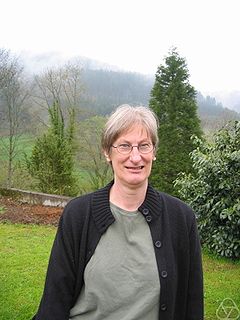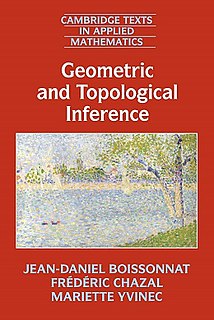Related Research Articles

In mathematics, topology is concerned with the properties of a geometric object that are preserved under continuous deformations, such as stretching, twisting, crumpling, and bending; that is, without closing holes, opening holes, tearing, gluing, or passing through itself.

Algebraic topology is a branch of mathematics that uses tools from abstract algebra to study topological spaces. The basic goal is to find algebraic invariants that classify topological spaces up to homeomorphism, though usually most classify up to homotopy equivalence.
In mathematics, homology is a general way of associating a sequence of algebraic objects, such as abelian groups or modules, with other mathematical objects such as topological spaces. Homology groups were originally defined in algebraic topology. Similar constructions are available in a wide variety of other contexts, such as abstract algebra, groups, Lie algebras, Galois theory, and algebraic geometry.
Sergei Petrovich Novikov is a Soviet and Russian mathematician, noted for work in both algebraic topology and soliton theory. In 1970, he won the Fields Medal.
Algorithmic topology, or computational topology, is a subfield of topology with an overlap with areas of computer science, in particular, computational geometry and computational complexity theory.

Mathai Varghese is a mathematician at the University of Adelaide. His first most influential contribution is the Mathai–Quillen formalism, which he formulated together with Daniel Quillen, and which has since found applications in index theory and topological quantum field theory. He was appointed a full professor in 2006. He was appointed Director of the Institute for Geometry and its Applications in 2009. In 2011, he was elected a Fellow of the Australian Academy of Science. In 2013, he was appointed the Elder Professor of Mathematics at the University of Adelaide, and was elected a Fellow of the Royal Society of South Australia. In 2017, he was awarded an ARC Australian Laureate Fellowship. In 2021, he was awarded the prestigious Hannan Medal and Lecture from the Australian Academy of Science, recognizing an outstanding career in Mathematics. In 2021, he was also awarded the prestigious George Szekeres Medal which is the Australian Mathematical Society’s most prestigious medal, recognising research achievement and an outstanding record of promoting and supporting the discipline.

Jenny Harrison is a professor of mathematics at the University of California, Berkeley.

Dennis Parnell Sullivan is an American mathematician known for his work in algebraic topology, geometric topology, and dynamical systems. He holds the Albert Einstein Chair at the City University of New York Graduate Center and is a distinguished professor at Stony Brook University.

In topology, the Vietoris–Rips complex, also called the Vietoris complex or Rips complex, is a way of forming a topological space from distances in a set of points. It is an abstract simplicial complex that can be defined from any metric space M and distance δ by forming a simplex for every finite set of points that has diameter at most δ. That is, it is a family of finite subsets of M, in which we think of a subset of k points as forming a (k − 1)-dimensional simplex ; if a finite set S has the property that the distance between every pair of points in S is at most δ, then we include S as a simplex in the complex.
Discrete Morse theory is a combinatorial adaptation of Morse theory developed by Robin Forman. The theory has various practical applications in diverse fields of applied mathematics and computer science, such as configuration spaces, homology computation, denoising, mesh compression, and topological data analysis.
In applied mathematics, topological based data analysis (TDA) is an approach to the analysis of datasets using techniques from topology. Extraction of information from datasets that are high-dimensional, incomplete and noisy is generally challenging. TDA provides a general framework to analyze such data in a manner that is insensitive to the particular metric chosen and provides dimensionality reduction and robustness to noise. Beyond this, it inherits functoriality, a fundamental concept of modern mathematics, from its topological nature, which allows it to adapt to new mathematical tools.

Karen Vogtmann is an American mathematician working primarily in the area of geometric group theory. She is known for having introduced, in a 1986 paper with Marc Culler, an object now known as the Culler–Vogtmann Outer space. The Outer space is a free group analog of the Teichmüller space of a Riemann surface and is particularly useful in the study of the group of outer automorphisms of the free group on n generators, Out(Fn). Vogtmann is a professor of mathematics at Cornell University and The University of Warwick.

Ronald Brown is an English mathematician. Emeritus Professor in the School of Computer Science at Bangor University, he has authored many books and more than 160 journal articles.
This glossary of areas of mathematics is a list of sub-discliplines within pure and applied mathematics. Some entries are broad topics, like algebra, while others are narrower in scope, like convex geometry.

Gunnar E. Carlsson is an American mathematician, working in algebraic topology. He is known for his work on the Segal conjecture, and for his work on applied algebraic topology, especially topological data analysis. He is a Professor Emeritus in the Department of Mathematics at Stanford University. He is the founder and president of the predictive technology company Ayasdi.
Dan Burghelea is a Romanian-American mathematician, academic, and researcher. He is an Emeritus Professor of Mathematics at Ohio State University.

Geometric and Topological Inference is a monograph in computational geometry, computational topology, geometry processing, and topological data analysis, on the problem of inferring properties of an unknown space from a finite point cloud of noisy samples from the space. It was written by Jean-Daniel Boissonnat, Frédéric Chazal, and Mariette Yvinec, and published in 2018 by the Cambridge University Press in their Cambridge Texts in Applied Mathematics book series. The Basic Library List Committee of the Mathematical Association of America has suggested its inclusion in undergraduate mathematics libraries.
Lou Kondic is an applied mathematician and Distinguished Professor in the Department of Mathematical Sciences at the New Jersey Institute of Technology (NJIT). His research focuses on thin film fluid dynamics, complex flows and granular media.
Aurora Evelyn Clark is an American computational chemist. She is a Professor in the Department of Chemistry at Washington State University (WSU) and Director of WSU's Center for Institutional Research Computing. Clark is a Fellow of the American Chemical Society, American Physical Society, and American Association for the Advancement of Science.
References
- 1 2 "Dr Vanessa Robins", People, Australian National University Research School of Physics, retrieved 2020-05-04
- ↑ Vanessa Robins at the Mathematics Genealogy Project
- ↑ Edelsbrunner, Herbert; Morozov, Dmitriy (2013), "Persistent homology: theory and practice" (PDF), European Congress of Mathematics, Eur. Math. Soc., Zürich, pp. 31–50, MR 3469114
- ↑ "The art of science in jewellery, metal, tape and music", Science in Public, 9 December 2014, retrieved 2020-05-04; "Julie Brooke: Minimal Surfaces", Art Almanac, 30 March 2015, retrieved 2020-05-04